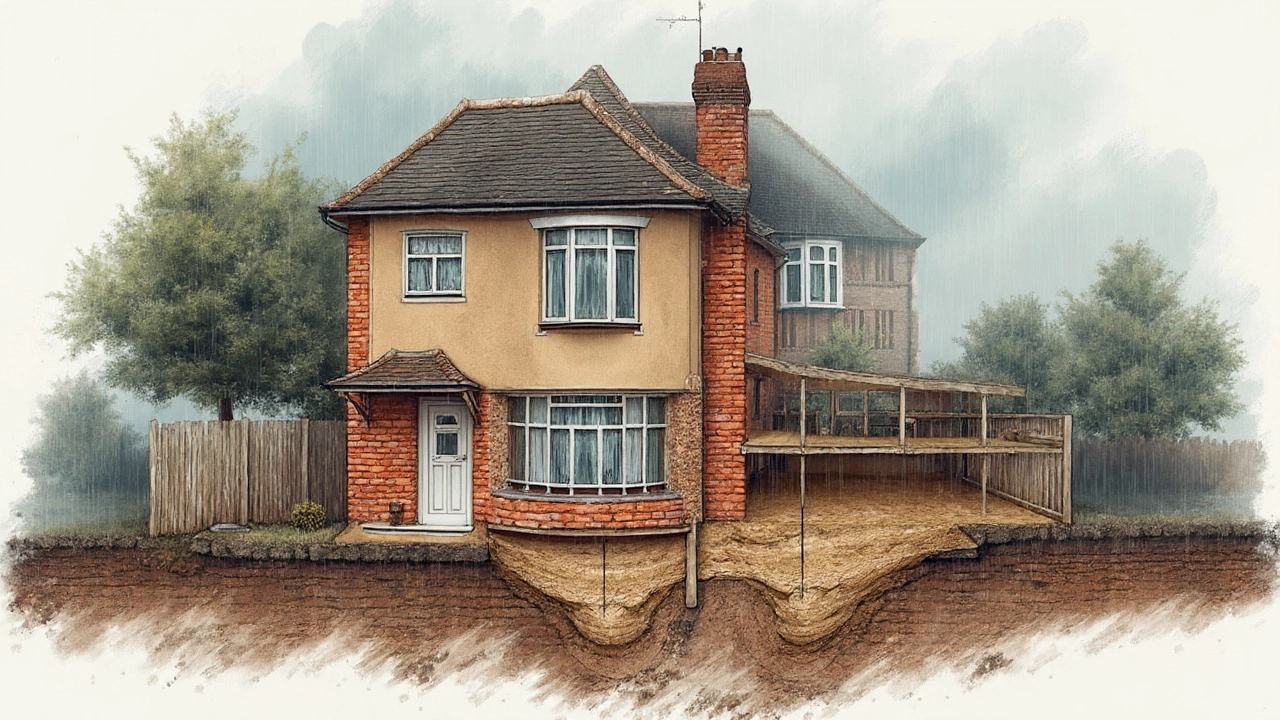One day you're just vacuuming your living room when you spot a crack zigzagging up the wall. Or maybe that sticky door finally won't budge and you notice your floors are starting to slope wildly. It's enough to make your stomach drop. People worry about leaks, old roofs, and wonky plumbing—but when you realize your house might have foundation problems, it gets far more real. Foundation issues can mess with your peace of mind (ask my cat Luna, who hates when I stomp around checking the floors). And if you don't act, a small hairline crack can escalate into a full-on tilt-a-house situation. So let's unpack what you can do right now if you spot trouble, before things get way out of hand.
Understanding Foundation Problems: Causes and Myths
Most people think of dramatic disasters when they hear "foundation problems"—like a massive crack splitting the house in two or vines crawling through the basement wall. The reality is more boring… and honestly scarier, because foundation issues often start out subtle. It's important to grasp what truly causes these problems so you're not chasing ghosts—or missing what matters.
So, what goes wrong with house foundations? Age is a big factor, but not the only one. In many parts of the U.S., the local soil is the villain. Certain clay soils expand and contract with rain and drought, moving the foundation little by little. One crazy fact: Texas, Louisiana, and parts of Oklahoma see repair crews constantly because of these "shrinking-swelling" soils (a 2023 survey from a Dallas foundation firm found that 60%+ of homes built before 1980 had major settlement repairs within 35 years). If you happen to live on sandy soil, you might get more shifting and settling after a dry spell or a burst water main. On the flip side, areas with a naturally high water table (think: Florida, New Orleans) face pushed-up, heaving slabs.
Weather also plays a role. Drought dries out the soil, letting the foundation drop. Heavy rain or snowmelt can wash soil out from under your house (hello, sudden cracks after that last bad storm?). Even big trees with roots slurping up moisture from under your home can make things move. And here's something folks don't consider: poor drainage. When rainwater or melted snow pools around your house, it soaks in, weakens the soil, and actually creates the conditions for your foundation to slide or tilt. It’s not always dramatic—sometimes it’s slow and sneaky. But over time, it matters.
Of course, some folks think foundation cracks mean their house is about to fall down, while others ignore big warning signs. A little hairline crack in a concrete slab can be harmless, but other issues—like cracks zigzagging through bricks, wide gaps near corners, or sticky windows—signal bigger trouble. To avoid being paranoid or careless, you need to know the specifics (don’t worry, we’ll cover those in detail next).
One last myth to bust: houses don’t always settle evenly. Even brand-new homes might show a few minor cracks as they adjust to the soil and seasons. That doesn't mean you’re doomed; it just means keeping an eye on changes over time instead of panicking over every new crack.
Spotting the Warning Signs: What Indicates Foundation Trouble?
Foundation problems can show up in sneaky ways, and you really want to learn these signs—catching problems early can save you huge bills and headaches later. Sometimes you find a clear crack, but plenty of symptoms don’t look like “foundation issues” at all. I still remember my neighbor thinking her creaky doors were just a seasonal thing until an inspector found her back corner sinking half an inch every year. So don’t just write off weird problems—here’s a list of red flags to watch for:
- Cracks in walls and ceilings: Not all cracks are doom, but wide ones (especially ¼ inch or more), long stair-step patterns in brick, or cracks that show up suddenly should make you pause and investigate further.
- Doors and windows that stick or won't close right: This isn’t just a seasonal swelling problem—when one side of your house settles, the frame gets twisted so the door or window becomes crooked.
- Uneven or sloping floors: Put a marble at one end—if it rolls fast to the other, you might have more than an old-house charm issue! Sometimes floor tiles even pop or crack.
- Gaps around window frames, exterior doors, or garage doors: Look for daylight, shifting caulk, or trim that’s pulling away.
- Cracks in the foundation itself: Check both inside and outside. Wide, horizontal cracks or ones that run through bricks, not just mortar, scream structural stress.
- Bulging or bowing walls: Especially in basements—often a sign the wall is under extreme soil pressure and might fail if ignored.
- Damp crawl spaces, puddles in the basement, or moldy smells: Excess moisture from leaks or bad grading can not only cause foundation settling, but also attract pests or rot out support beams.
- Chimneys pulling away from the house: This is a classic, dramatic sign. Chimneys often sit on their own little slab, so if it’s tilting or leaning, look closer fast.
You don’t need to freak out over every pin-sized crack, but the big thing to watch is change. If that door used to close fine but now only shuts after you slam it, or if new cracks keep popping up where there were none last summer, it’s time to check under the hood. Document everything: snap photos of cracks, mark the ends with a pencil and the date, and note noises or weird smells. All this helps if you call in an expert—and makes it much harder for anyone to brush off what you describe.
Foundation warning signs can appear gradually or after just one bad weather event. For example, after Hurricane Ida hit New Orleans in 2021, insurance adjusters saw a 34% spike in structural claims just for homes in low-lying zones. That’s why the context around new symptoms—like a recent drought, nearby excavation, or even a big tree suddenly dying—matters as much as what you see on the surface.
Got a hunch something’s weird? Trust your gut, and don’t wait long for issues to "fix themselves." Foundation repairs grow way more expensive as things worsen. Early action pays off fast.

What To Do First: Inspection, Diagnosis, and Prevention
So you’ve found a worrying crack or your floors are suddenly channeling a funhouse. What now? The first instinct people get is to DIY everything, but foundation issues aren’t like a leaky faucet—there’s a science (and sometimes, a legal requirement) behind fixing them right. You want to start with three main steps: inspection, accurate diagnosis, and prevention, all before you hire a repair crew or break out that bag of concrete patch.
Step one: Document and measure. Take smartphone pics of all cracks, sloping spots, sticking doors, and weird gaps. For cracks, mark their ends with pencil and write the date, then check every couple of weeks for changes. This sounds obsessive, but professionals love having accurate records—plus, you’ll avoid paranoia if a crack never actually grows.
Step two: Get a trusted home inspector or (even better) a structural engineer to check things out. Foundation repair companies will often do free estimates, but their advice is sometimes sales-driven. Licensed engineers, on the other hand, don’t profit from the repair, so they’re more objective. The 2024 HomeAdvisor report found the average cost for a foundation inspection is $400–$600—sounds steep, but catching problems early can save you thousands. Fun fact: If your place is under warranty or part of an HOA, there may be rules about who must do these checks, so check your paperwork first.
Next, ask for a detailed written report. You want specifics about what’s causing the symptoms (settling, heaving, rot, or even termites), not just a "needs fixing" verdict. The more granular the findings, the better solutions you’ll have.
Third, prevention. Even if your foundation turns out fine, take steps to keep it healthy. Check drainage: gutters should send water at least 6 feet away from your house, according to the International Association of Certified Home Inspectors. Set your downspouts right, make sure water doesn’t pool next to the foundation after rain, and consider adding landscape grading if the yard tilts toward your house. Want to go further? Install a sump pump if your basement gets wet, and prune big trees whose roots could undermine your foundation slab or pier over years.
A simple but vital tip: monitor your humidity. In areas with lots of foundation movement, experts recommend keeping soil moisture as stable as possible year-round. This can mean special soaker hoses in a Texas summer, or smart irrigation setups that water lightly but regularly to avoid crazy drying or soaking. Bonus: Your floors will creak less, and your pets (like Luna!) will appreciate a steady, not-musty home.
If you spot bugs, rotten beams, or standing water, don’t put off repairs—moisture and pests don't just crumble wood, but also attract termites, which can turn a small foundation problem into a total rebuild. Early, decisive action really is cheaper and easier.
| Service | Low End | High End |
|---|---|---|
| Home Inspection | $250 | $600 |
| Foundation Engineer Report | $400 | $900 |
| Small Crack Patch | $250 | $800 |
| Major Structural Repair | $7,000 | $30,000+ |
Remember: Don’t ignore the small stuff, stay organized, and trust professional boots on the ground over DIY patch jobs for anything besides cosmetic fixes.
Your Repair Roadmap: Solutions, Costs, and Staying Safe
Okay, you’ve confirmed you have foundation problems—now for the million-dollar question: How do you fix it (and how much will it hurt the wallet)? The choices range from DIY patches to full-blown crew-and-crane operations, so knowing what’s realistic cuts down on stress and scams.
Basics first: hairline cracks on the surface, especially vertical ones within an inch or two, can be addressed by cleaning with a wire brush and injecting epoxy or polyurethane. Keep an eye on them, though. But once you see major gaps, sinking floors, or doors warped so badly you’re climbing out the window, you’ve hit structural territory. There’s no safe sticker-tape repair for a foundation sliding an inch or more.
For serious fixes, contractors use methods like underpinning (adding piers or pilings under the foundation to lift and stabilize it) or mudjacking (pumping a slurry under a settled slab to push it back up). In really bad cases, they might install helical piers—special steel screws drilled deep into the soil—to literally anchor your house. Each workflow comes with its price tag: underpinning usually lands between $6,000 and $18,000, but complex homes, access issues, or historic buildings can cost double or more. Here in the U.S., the average full-blown foundation repair job lands just under $13,000 as of spring 2025, according to Foundation Repair Network stats—and yes, insurance rarely covers it unless caused by a sudden event like flooding.
- Epoxy injections for minor cracks: fast, affordable, but not a solution for structural movement.
- Piers/pilings: best for settlement or when part of the house drops lower than the rest.
- Mudjacking (slabjacking): works on flat slabs—injects a cementitious mixture under sunken areas.
- Wall anchors or braces: used for bowing basement walls, they pull the wall straight over time.
- Drainage correction: sometimes the cheapest and most effective—redirecting water away so the soil doesn’t move as much.
Always get multiple bids and ask lots of questions: Are you licensed and insured? Do you provide a warranty? How long will the job take? What happens if the foundation keeps moving? Most legit firms offer lifetime warranties, but read the fine print—they sometimes only transfer to future owners for a set number of years. If you live in a historic house or a zone prone to movement, paying extra for a seasoned engineer to supervise repairs is worth every penny.
Now, don’t get pressured. Some scammy companies prey on worried homeowners and try to rush them into contracts. Take your time, sleep on big decisions, and check plenty of reviews before cutting a massive check. Reliable pros will explain each step, never talk over your head, and happily show you their insurance/licensing.
Soon after repairs, expect things to be a bit messy. Your floors might need patching, you might get a little dust, and your landscaping probably won’t thank you. But foundational stability isn’t the place to cut corners. If you do choose to sell your house one day, having the paperwork for solid repairs protects you legally, bumps up your selling price, and keeps surprises away during inspection time.
One last thing—prevention isn’t over after you fix things. Watch for new cracks, keep water draining away, and check every spring after the soil thaws or after a crazy big storm. It’s kind of like brushing your teeth after a filling: do it now so you don’t end up back in the (wallet) dentist’s chair.



